BPA in packaging: Defying the pressure
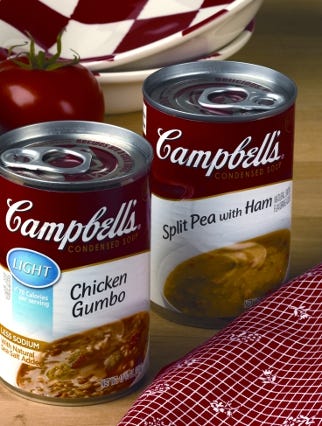
Campbell Soup cans
Bisphenol-A. Has an organic compound divided the world as much as this synthetic estrogen? While this chemical instills much controversy, anger, fear and frustration on one side, the other side merely sees it as a protector of food that helps packaging withstand the high temperatures of retort and, overall, increases a product's shelf life.
BPA is a building block for polycarbonate (PC) and epoxy resins used in linings for metal food/beverage cans and metal closures for glass containers. Physiologically, BPA is said to mimic the hormone estrogen and some studies have linked it to increased breast cancer risk, obesity and other health conditions.
This is partly how BPA became a villain in food packaging, at least in some people's eyes. News reports in the general media in the last several years have done much to feed consumers' fear. (Visit www.packagingdigest.com/BPAhistory for background on the development, use and controversy of BPA in packaging, including a timeline of key events.)
"If you stop 10 people on the street, and ask them about BPA, they know right away that it's supposed to be considered bad," says Stuart Yaniger, vp of research and product development at PlastiPure. "But if you ask a follow-up question about why it's bad, expect to get a blank look because they don't know why."
The FDA vs the NRDC
For decades, the U.S. government has claimed low doses of BPA are safe.
In 2008, the environmental advocacy group The Natural Resources Defense Council (NRDC)—which calls itself "the earth's best defense"—took a stand against BPA and asked the Food and Drug Administration (FDA) to eliminate the chemical from all food packaging.
When the agency didn't take action, the NRDC sued the FDA in 2011, and asked the Federal court to compel the agency to respond. Later that year, the court issued a consent decree requiring FDA to make a final decision on NRDC's petition by Mar. 31, 2012.
March 31 rolled around, and the FDA ultimately decided not to ban BPA from food packaging because the NRDC petition did not have the scientific data needed for the FDA to change current regulations. A FDA spokesperson says the decision was "not a final safety determination, and the FDA continues to support research examining the safety of BPA."
While the FDA says some studies have raised questions as to whether BPA could be associated with a variety of health effects, the agency still has "serious questions about the studies, particularly as they relate to humans and the public health impact of BPA."
FDA is working toward completing another updated safety review on BPA this year to include all relevant studies and publications, and is also working with the National Institute of Environmental Health Sciences, which has invested $30 million into research on BPA.
Where industry stands
Even before the FDA made its most recent decision, several U.S. companies had started to remove BPA from their food packaging.
However, the party line seems to be that, until the regulation says otherwise, companies will continue to use BPA in their packaging while searching for alternatives. But if there is a sense of urgency at North American food and beverage companies and involved packaging suppliers to find and use BPA alternatives, they mask it well.
In response to queries about BPA in packaging, Campbell Soup, H.J. Heinz, Coca-Cola and General Mills—as well as representatives from metal can manufacturers—submitted statements on their positions:
Campbell Soup aseptic box
• Campbell Soup: Campbell Soup CFO Craig Owens told analysts earlier this year about plans to remove BPA from all of its packaging: "We believe that current can packaging is one of the safest options in the world. However, we recognize that there's been some debate over the use of BPA. The trust we've earned from consumers for over 140 years is paramount to us. Because of this, we've already started using alternatives to BPA in some of our soup packaging. And we're working to phase out the use of BPA in the linings of all of our canned products. The cost of this effort is not expected to be material."
Campbell Soup also uses aseptic cartons for some ready-to-serve (RTS) soups, but it opted for that package for marketing reasons, not because of an issue with BPA, says company spokesman John Faulkner. He adds, "We offer numerous types of packaging alternatives to fit different usage occasions. We will continue to offer soup in cans—both condensed and RTS, but those cans will increasingly be BPA free."
• H.J. Heinz: Company spokesperson Michael Mullen says, "Heinz has been recognized for our leadership in moving to alternative materials that are BPA free. Additionally, our can use is very limited and we have been assured by our suppliers that there is no BPA in any plastic containers we use."
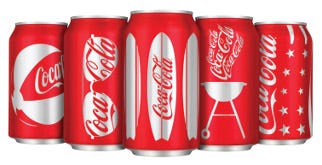
Coke summer cans
• The Coca-Cola Co.: Coca-Cola outlines its position in the company's 2010/2011 Sustainability Report and website documents titled "Aluminum Can Safety" and "Bisphenol A (BPA) Assessment." Here are some excerpts:
"We will continue to take our guidance on this issue from national and international regulatory authorities, and we will take whatever steps are necessary, based on sound scientific principles, to ensure that any package technology is safe for our consumers.
"If we had any concerns about the safety of our packaging, we would not use it.
"We are aware that a limited number of metal can producers are using an older generation of can lining material as an alternative for some specialty products. Such alternatives do not work for the mass production of aluminum beverage cans, and they do not work for all types of food or beverages.
"We would not replace a packaging material we are confident is safe with one that is not proven or effective. ...We have been considering more than a dozen possible options as alternatives to liners containing BPA.
"Any new material, assuming it has all necessary regulatory approvals, also would have to meet our requirements for safety, quality, taste and performance."
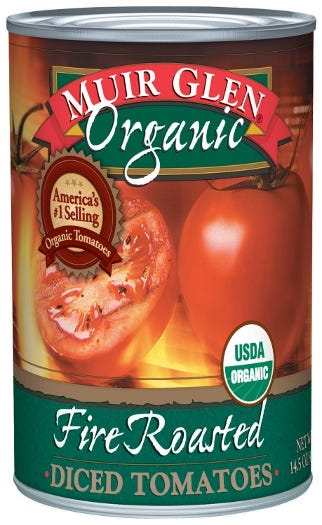
General Mills Muir Glen can
• General Mills: A spokesperson from the company sent this reply: "We know that some of our consumers would like us to pursue alternatives—and we are working with our can suppliers to develop and test alternative linings that do not use BPA.
"Working with our can suppliers and can manufacturers, Muir Glen was able to develop and test a safe and viable alternative that does not use BPA for our canned tomato products. We began transitioning to can linings that do not utilize BPA with the fall 2010 tomato pack, and we completed that transition with the 2011 tomato pack.
"While viable alternatives have not yet been identified for all products, we are continuing to work with our suppliers on alternatives for other products and packaging applications. When safe and viable alternatives are identified for such products, we would expect food manufacturers to make the transition to can linings that do not utilize BPA-not out of any concern for safety, but in response to consumer interest."
• North American Metal Packaging Alliance Inc. (NAMPA): John Rost, PhD, chairman of the North American Metal Packaging Alliance Inc. (NAMPA), shares the industry's current position on BPA alternatives for epoxy resins in metal can/closure linings as they relate to cost, performance, availability and safety.
"There is a great deal of research underway at all times, but the fact remains: There is no readily available alternative to BPA for all the types of metal food and beverage packaging currently in use. There are more than 1,700 different specific performance and safety characteristics that cover the range of foods and beverages packed in cans.
"We are all working to find innovative alternative solutions and doing so in a highly competitive and demanding market environment. As you can imagine, information on new technologies is considered highly proprietary and is not publicly available.
"I can tell you that, although many new coatings developments are well under way, it takes several years for viable alternatives to be developed, tested, approved by FDA and then brought to the commercial market. The typical timeframe includes about one to three years for coating development; two years for application trials and pack testing; and another six months to two years for commercialization."
• Ball Corp.: Scott McCarty, director, corporate relations at Ball Corp., sent the company's official statement, which says, "Ball recognizes that significant interest exists in offering alternatives to epoxy-based coatings, and we have been proactively working with coatings suppliers and our customers to evaluate next-generation coatings. Ball has converted some foods to cans that use an FDA-approved non-epoxy-based coating, typically involving less acidic products. We are committed to responding to our customers' needs. If interest continues in non-epoxy-based coatings, Ball will offer cans with those coatings when the coatings become commercially available."
The non-epoxy-based coating that Ball refers to is oleoresin, a mixture of an oil and a resin extracted from plants, such as pine or balsam fir. This was used before epoxy resins were developed. Ball has been supplying Eden Foods with oleoresin-lined food cans for several years.
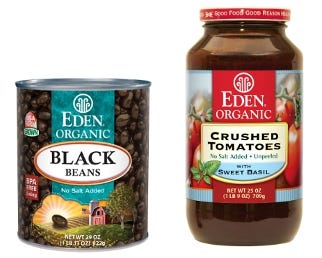
Eden Foods BPA-free pkg
• Eden Foods: Instead of a canned response, Michael Potter, CEO at organic food company Eden Foods, spoke freely and passionately about his views and experiences.
In the late 1990s, after reading news reports from Germany about BPA concerns in canned food, Potter started a frustrating, two-year investigation into the chemicals contained in the metal cans his company used. "I was subjected to a skillful, well-organized effort to spin me away from my inquiries," Potter relays. "I buy millions of these cans a year. Don't I have a right to know what I'm buying? I'm feeding this to my children and grandchildren."
What he eventually learned was that BPA is "less than a perfect chemical formula," he says. As various ingredients are combined to make epoxy linings, not all the targeted chemical reactions complete themselves. "As the can lining forms and hardens, some of the chemical reactions create transitional chemical reactions and are trapped in the lining. Subjected to normal storage conditions and retort, some of these chemicals leach into the food," Potter explains.
Eden Foods began the switch in April 1999 with its 15-oz bean cans, and has since converted its 29-oz size and #10 cans for a number of low-acid products. Today, 100 percent of the cans for low-acid foods for the Eden brand are BPA free—and are identified as such on the label, as well as in marketing materials. Ball is still Eden's sole supplier of BPA-free cans.
Sourcing BPA-free cans has had a pretty steep price. Potter admits that his initial order cost 14 percent more. Over the years, that differential grew to almost 30 percent at one point. Today, the average is about 20 percent (different sizes have different percentages). In the intensely competitive food business, margins are too thin to absorb the increase: Potter says the cost of BPA-free cans—which represents about half the cost of a can of beans, for example—has been passed along to customers, who seem to appreciate or at least accept the company's efforts. "I can't tell you the gratitude we get from our customers," Potter says. "That helps sustain us and helps create loyal customers."
In January 2011, Eden Foods even switched from metal cans to amber glass jars for high-acid organic crushed tomatoes and tomato sauces to avoid BPA. And the company minimized the potential for BPA migration from the closure liner. As Eden Foods explained to Treehugger, "the inside of the twist caps has two coats of sealer between the food and the metal of the cap. The first applied coating has BPA present. The second protective sealant does not, isolating the first coating from contact with the jar's contents."
Potter doesn't see these efforts as going too far. He cautions, "As American consumers learn more about this, they're going to avoid what they don't want."
If not BPA, then what?
For some products, glass, stainless steel and aseptic packaging (such as cartons from Tetra Pak and SIG Combibloc) could be alternatives to BPA-containing polycarbonate containers. Or, staying with plastic packaging, PC substitutes could be polyethylene terephthalate (PET), metallocene polypropylene (PP), high-density polyethylene (HDPE), polyamide (nylon) or some copolyesters.
Options for metal can/closure linings include polyester and polyacrylate can coatings, alkyd resins, polyvinyl chloride (PVC) organosols and the already-mentioned oleoresin.
Development of alternatives continues:
• In 2008, Michael Jaffe, a research professor of biomedical engineering at New Jersey Institute of Technology (NJIT), received a patent for a chemical derived from sugar. This new material was a derivative of isosorbide and may be able to replace BPA in a number of consumer products.
Jaffe says that instead of PCs, PET with isosorbide can be used for making a plastic, and that a form of isosorbide can replace epoxy resins in can linings.
Isosorbide can be synthesized from cornstarch. Both components of the epoxy—the resin and the hardener—are from water-soluble, plant-derived chemistries. The epoxy is cured by baking at an elevated temperature.
Jaffe says, "Sugar-based chemicals are attractive because they are generally regarded as safe, and are a renewable resource that can be made readily available at competitive pricing. Isosorbide offers molecular geometry and chemical functionality compatible with many chemistries."
• Agricultural processing giant Archer Daniels Midland (ADM) markets isosorbide as part of its Evolution Chemicals product range.
Isosorbide itself is a diol (an alcohol with two hydroxyl groups in each molecule) and can be used as a monomer in PCs and other condensation polymers. An ADM spokesperson says its customers are interested in isosorbide for numerous applications—including packaging.
• In 2008, a project by Heinz U.K. and international coatings manufacturer Valspar studied epoxy phenolic, epoxy anhydride, organosol and polyester polyurethane coatings on food cans to try to inhibit chemical migration into food. According to Materials World Magazine, one of the key parameters is curing times. Valspar now offers coatings for three-piece food cans that cure faster than before (the company did not reply to questions about how much faster by our deadline).
• Valspar has also patented BPA- and aromatic glycidyl ether-free coatings and a method to apply them to metal substrates by conventional means such as brushing, roller coating or spraying. According to the patent, the bisphenol-A (BPA), bisphenol-F, bisphenol-A diglycidyl ether (BADGE) and bisphenol-F diglycidyl ether (BFDGE)-free coatings include an under-coat of a polyester (co)polymer, and an under-coat cross-linker; and an over-coat containing a poly(vinyl chloride) (co)polymer dispersed in a substantially non-aqueous carrier liquid, an over-coat cross-linker and a functional (meth)acrylic (co)polymer.
• As a substitute for BPA polymers, Seattle Polymer LLC has developed hydrogenated bisphenol-A-based polymers-containing 4-[2-(4-hydroxycyclohexyl)propan-2-yl]cyclohexan-1-ol (HBPA) and derivatives of HBPA-that exhibit lower toxicity. In some instances, HBPA showed values that the inventors claim are nearly half as toxic as BPA. According to the patent, "The difference in toxicity of HBPA-based monomers compared to BPA-based monomers is likely because of the differences in structure and reactivity of the aliphatic alcohols and carboxylic acids compared to their aromatic counterparts."
The HBPA-containing polymers can be inexpensive and easy to make by using current technology, according to the inventors. In some embodiments of the invention, the random, block or graft (co)polymer is an alkyd resin, a polycarbonate, a polyurethane or an epoxy resin, and may be cross-linked.
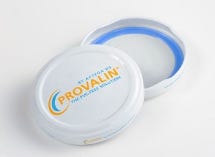
Actega Provalin
• Coatings manufacturer Actega DS has introduced Provalin, a new metal closure compound based on advanced thermoplastic polyolefin (TPE) technology that is BPA-, melamine-, PVC- and plasticizer-free. Available from development partner Pano Verschluss GmbH in its Pano Blueseal metal seals, Provalin touts low migration characteristics and has been used by German natural food supplier Bruno Fischer for its range of spreads.
• Plastics and chemicals supplier Borealis has launched a more transparent extrusion blow-molding grade of polypropylene specifically designed for cosmetics and baby bottles, with an eye on capturing marketshare forsaken by PC.
The company says its Borclear RC737MO offers a "leap forward" in aesthetics by influencing the gloss, haze and clarity of bottles. The new PP bottles can be processed by applying the usual processing settings for random PP grades, with barrel temperatures in the range of 190 to 220 deg C. Its higher melt strength enables converters to more easily regulate wall thickness.
"Compared to PC, this PP grade shows better machine running cost efficiency and lower pressure needed to blow mold, improved safety and cost reduction," a Borealis spokesperson says.
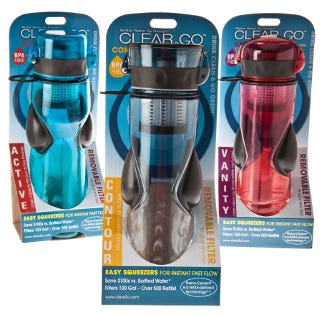
Eastman Tritan
• One of the biggest criticisms of PC alternatives is the lack of toughness and clarity. Eastman Chemical believes its Tritan copolyester resolves those concerns. The company touts its Tritan material, introduced in 2007, as a drop-in replacement for PC in food-contact applications. BPA is not an ingredient or by-product of the production of Tritan. And independent testing demonstrated that Tritan is free of estrogenic and androgenic activity, according to Eastman (visit www.packagingdigest.com/TritanLawsuit for breaking news).
Solving the underlying issue
BPA-free products may bring comfort to some, but not PlastiPure's Yaniger. He argues that a greater emphasis must be placed on chemicals and materials that exhibit estrogenic activity (EA), and says some BPA-free materials are not EA-free.
Yaniger says, "The idea that you take one chemical away and somehow it's all OK now, it's a ridiculous thought. You have to fix the entire problem, and in some cases, the estrogenic activity hasn't been addressed."
PlastiPure works with companies throughout the entire plastics supply chain to develop EA-free materials, compounds, colorants, processing aids and PlastiPure-Safe certified EA-free products.
Environmental Health Perspectives (EHP), a peer-reviewed journal published by the National Institute of Environmental Health Sciences, published a scientific article from researchers at PlastiPure, CertiChem and Georgetown University, which focused on quantifying and addressing the potential health issue of EA in plastic products.
The results of this study indicate that almost all the plastic products leached chemicals that had detectable EA, including those advertised as BPA-free. Leaching increases when products are subjected to common-use stresses, such as dishwashing, microwaving and exposure to sunlight.
"In some cases they [BPA-free producers] are making polymers that are just as estrogenic," Yaniger says. "This is a huge issue, and we haven't fixed the problem. In one sense BPA-free is viewed as marketing, not a health issue."
Ready or not
The idea that BPA replacements may themselves be safety suspects is just breaking. An article in the May-June 2012 issue of Audubon magazine asks "How Safe Are BPA Alternatives?" (the answer: not as safe as you may think); a May 29, 2012, advisory on the website of certified B corporation Care2 announces "New BPA Substitute May Be Equally Dangerous"; and a June 6, 2012, consumer alert on OpEdNews.com reports "BPA-Free Goods Still Contain Toxic Bisphenol."
With each new story in the general media about BPA—and with each BPA alternative introduced that meets the performance, cost, availability and safety requirements of food and beverage companies—the closer the plastics and packaging industries inch toward the tipping point of larger-scale conversion. They're not there yet but that's still the direction they're headed.
Archer Daniels Midland (ADM), 800-637-5843. www.adm.com
Actega DS, +49 281 670-10600. www.actega.com
Ball Corp., 303-469-3131. www.ball.com
Borealis, 908-850-6200. www.borealisgroup.com
CertiChem, 888-666-6604. www.certichem.com
Eastman Chemical, 423-229-2000. www.eastman.com
Food and Drug Administration, 888-463-6332. www.fda.gov
National Institutes of Environmental Health Sciences, 919-541-3345. www.ntp.niehs.nih.gov
Natural Resources Defense Council (NRDC), 212-727-2700. www.nrdc.org
New Jersey Institute of Technology, 973-596-3000. www.njit.edu
North American Metal Packaging Alliance Inc. (NAMPA), 866-522-0950. www.metal-pack.org
Pano Verschluss GmbH, +49 48 21-77 06-0. www.panocap.de
PlastiPure, 866-999-5221. www.plastipure.com
Seattle Polymer LLC, 607-745-5828. www.seattlepolymer.com
SIG Combibloc, 610-546-4200. www.sig.biz
Tetra Pak, 847-955-6000. www.tetrapak.com
Valspar, 800-873-5575. www.valsparglobal.com
.
About the Author(s)
You May Also Like




